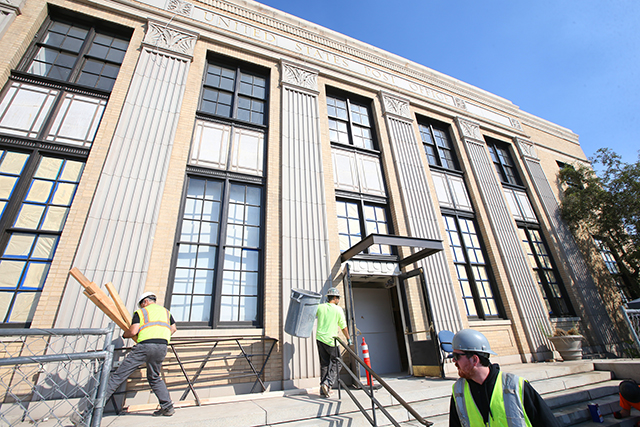Hey, this tea tastes like my yard
Published 5:00 am Tuesday, July 27, 2010

- Michael Tortorello picks mint leaves from his garden to use in his tea in Minneapolis. Herbs for tea blends can be grown in a home garden, and should be sampled by trial and error to find the right blend.
The first Tea Party got one thing right: Drinking tea is un-American. Camellia sinensis, the common tea shrub, will survive in most warm, humid climates. But tea plantations never took root in American soil.
The evils of Asian tea and British customs duties may not top the Tea Party platform these days. But the Glenn Becks of the 1770s were compelled to invent their version of freedom fries — a drink they called liberty tea. They made it from plants like goldenrod and Labrador tea (Ledum groenlandicum, a variant of the heath family). Newspapers published herbal recipes, mixing common plants like peppermint, marjoram, hyssop, rosemary, raspberry, lavender, fennel, dill and thyme.
Trending
It helped that the colonists did not have to look far for their new brew. Herbal treatments already represented the foundation of Colonial-era medicine. And herbs could be found in nearly every yard and garden. Still, it was nothing less than a revolution that helped move herbal tea from the medicine cabinet to the kitchen table.
Like the colonists, I recently found that I had the makings of a perfectly good tea garden growing outside my kitchen window. And I realized I wouldn’t mind declaring independence from packaged herbal teas. The boxes seem to linger in the cabinet forever, with their peppy nostrums (cribbed from Ben Franklin?) and their pictures of wizards and bears.
Yet not every plant in the herb garden belongs in a teacup, according to Kathleen Gips, proprietor of the Village Herb Shop in Chagrin Falls, Ohio, 15 miles east of Cleveland. “Most of the culinary herbs like parsley and oregano are not really good in teas,” Gips said, adding that some are, like basil.
Gips, who is 63, has discovered a great thirst for herbal teas in her shop, in a quaint brick building from the 1880s, with demonstration gardens outside. She attributes this popularity largely to the tastings and classes she holds there. Americans once had a working knowledge of dozens of herbs, she said. “Everyone knew how to use them, and everyone knew how to grow them.”
Today’s kitchen gardener, by contrast, will probably need to rely on some trial and error. “Go out and use your nose,” Gips said. “Take a pinch, and see what tastes good to you.”
Outside her two-story Victorian home, a few blocks from the store, Gips raises “hundreds and hundreds” of herbs. But she winnowed down the list to a few favorites that were missing from my herb garden: lemon balm, lemon grass, lemon verbena, calendula (Calendula officinalis), catnip (Nepeta cataria) and chamomile (Anthemis nobilis).
Trending
A few weeks ago, I picked up most of these plants at a garden store. I also grabbed a few alternates like marshmallow (Althaea officinalis), echinacea and sweet cicely.
Close quarters
Most herbs can be started from seed. But given the short growing season in northern Ohio, Gips likes to start with seedlings.
Herbs don’t ask a lot of a gardener. Compost alone will feed these plants, she said. “Fertilizing herbs produces a lot of foliage but not a lot flavor,” Gips explained. She will water her herb pots twice a day when the temperature hits 80 degrees. (Containers with built-in reservoirs are a handy alternative for the unreliable and the lazy, not that you can’t be both.)
“Herbs love to be grown in pots,” Gips said. “They like those cramped quarters.”
It is hard to imagine a more crowded space than the second-floor fire escape in Flatbush, Brooklyn, where Jacoby Ballard grows herbs for his home-brewed teas. There are some half-dozen herbs out there — including chickweed (Stellaria media), mugwort (Artemisia vulgaris) and motherwort (Leonurus cardiaca) — and a variety of microgreens, too.
Ballard, 30, is a yoga teacher, health educator and herbalist with Third Root Community Health Center in Flatbush. And herbal infusions are a foundation of his practice. This spring, he put in a 50-foot-long garden strip on the sidewalk in front of the building.
What he doesn’t grow, he often scavenges. Like the original Tea Partiers, Ballard has a liberal sense of what is an herb and what is a weed.
“One of the first things to come up” in spring, he said, is plantain (Plantago major). It’s “a small little herb with a pretty, oval-shaped leaf.”
Mullein (Verbascum thapsus), he said, is bigger. “It especially tends to grow up in abandoned parking lots — ground that’s not so fertile.”
Burdock (Arctium minus), yellow dock (Rumex crispus), dandelion (the scourge of your lawn) — “these are all herbs that are frequently seen as weeds and thrown out,” he added.
For home tea, get an infuser
Ultimately, you won’t taste a thing if you try to steep these herbs in a tea ball. For $8 to $15, buy a one-cup infuser. I tried three models:
The silicone Tuffy Steeper telescopes into a portable disc, and the lid doubles as a drip-saucer. But it could have been tougher. The plastic collar tends to separate from the infuser.
The ForLife extra-fine infuser, made of sturdy stainless steel, may indeed outlive us all — and stay clean in the dishwasher, too.
The Finum Brewing Basket, with its thinner plastic frame, is more delicate. But it offers the failed tea-maker a reprieve: The fine stainless steel mesh would be ideal for brewing coffee.
— Michael Tortorello








